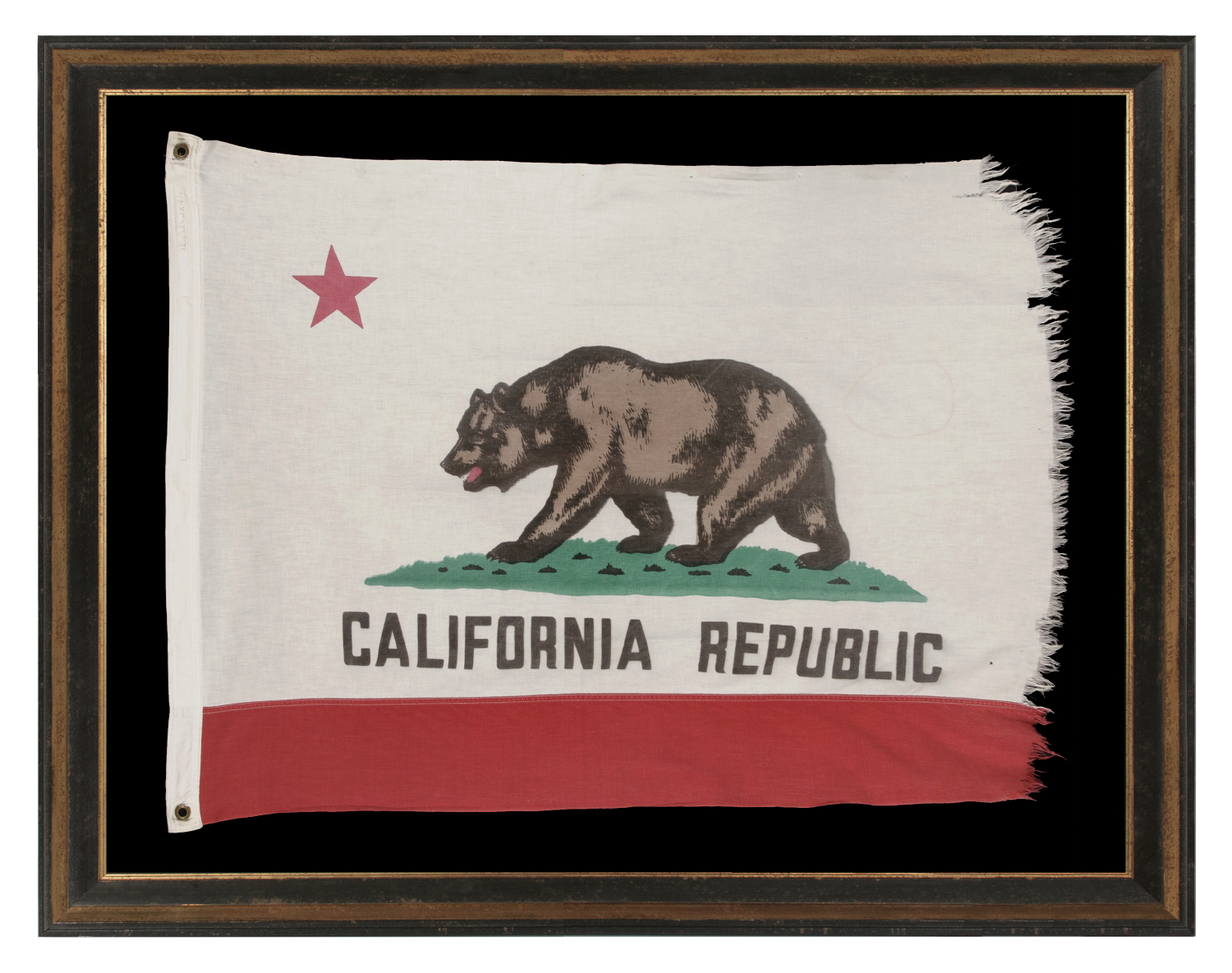
| |
VINTAGE CALIFORNIA STATE "BEAR FLAG" WITH ENDEARING WEAR, CIRCA 1960-1980 |
|
| Available: |
Sold |
| Frame Size (H x L): |
Approx. 46.5" x 60.5" |
| Flag Size (H x L): |
34.5" x 48.5" |
|
| Description....: |
|
Early state flags fall between very scarce and extraordinarily rare in the antiques marketplace. One primary reason for this is that most states, even if they existed during the 18th or 19th century, didn’t actually adopt flags until the early 20th century. The Maryland State Legislature, for example, didn’t find need for a state banner until 1904, in spite of the fact that Maryland was one of the original 13 colonies. Other states had crests or symbols that were tied to the state legislature in some way, or to local patriotism, but didn't accept an official design until many years following statehood.
In the case of California, the "Bear Flag," as all California state flags and variations thereof are often called, is based on a significant early example. The eldest of these is thought to date to the 1846 “Bear Flag Revolt,” which occurred when Major John Fremont arrived in the state on a so-called mission to reach the Pacific and encouraged an uprising against Mexican rule in the territory. Fremont claimed himself military governor of the California Republic and was brought up on charges of treason for his actions, but was pardoned by President James Polk. Polk was an expansionist and Fremont’s actions brought California to statehood in 1850, immediately following the 1849 Gold Rush.
The original Bear Flag was designed and made by William L. Todd, a first cousin to Abraham Lincoln’s wife, Mary Todd. Painted on cotton, it had a white field with a red stripe along the bottom, just the like modern design. The star image was taken from what was known as the “California Lone Star Flag”, flown during California's previous, 1836 revolt. Like the modern California flag, the red star appeared the upper hoist-end corner, but the bear was placed next to the star. On a later version, designed by a man named Peter Storm in 1870, the bear was fierce and walking. On the modern design it is black and brown, centered on the field, prominently huge, and walking.
The bear on the first bear flag and other early bear flags more closely resembles the more common American black bear than a grizzly, seen in the lack of shoulder hump and narrower muzzle. The bear on Storm’s 1870 version closely resembles the coat of arms of Bern, Switzerland, its capital city. The coat of arms displays a black bear walking toward the left with fierce claws and a protruding tongue. It is of interest to note that Switzerland was the home country of John Sutter, who established Sutter's Fort, in the area which would spawn the California Gold Rush and eventually become Sacramento, California's state capital.
On Todd’s 1846 flag, the words “California Republic” were likewise in black, but the letters spanned the width of the star and bear images and were placed immediately below them. Today they are underneath the large bear, just above the red bar. Unfortunately, Todd’s flag was destroyed in the fires following the 1906 San Francisco earthquake, but an image of it survives in a photograph, taken in 1890.
The bear flag did not become the official California state flag, however, until it was adopted by the California State Legislature and signed into law by Governor Hiram Johnson in 1911. States were regularly participating in World’s Fair events by this time—popular between the late 19th and mid 20th centuries—and were probably compelled to create state banners because other states had them, so it would have seemed improper not to obtain one and follow suit.
Because state flags are desired by modern antiques enthusiasts and because early copies are scarce or non-existent, I am sometimes compelled to acquire interesting vintage examples from the mid-latter 20th century. This particular "bear flag" is a fine example of that period. The white field and red bar are made of heavy cotton. These have been pieced together with machine stitching and the flag has been bound in the same manner. The bear, lettering and star are printed onto the white panel. There is a heavy canvas binding along the hoist, applied by machine and with two brass grommets. Along this the word "BEAR" is stamped in black ink, along with "3 x 4 1/2" to indicate size in feet.
Mounting: The flag was mounted and framed within our own conservation department, which is led by expert staff. We take great care in the mounting and presentation of flags and have preserved thousands of examples.
The background is 100% cotton twill, black in color. The black-painted, hand-gilded and distressed molding is Italian. The glazing is U.V. protective plexiglass.
Condition: There is significant loss along the fly end from obvious long-term use. There is a horizontal tear in the hoist binding, directly beneath the upper grommet. Many of my clients prefer flags to show their age and history of use. |
|
|
|
| Collector Level: |
Beginners and Holiday Gift Giving |
|
| Flag Type: |
Sewn flag |
|
| Star Count: |
|
|
| Earliest Date of Origin: |
1960 |
|
| Latest Date of Origin: |
1980 |
|
| State/Affiliation: |
California |
|
| War Association: |
|
|
| Price: |
SOLD |
|
| |
Views: 1631 |
|
|
|

